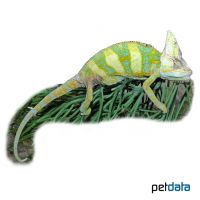Veiled Chameleon (Chamaeleo calyptratus)
| Veiled Chameleon Chamaeleo calyptratus | |
|---|---|
| Name | Veiled Chameleon |
| Name Lat. | Chamaeleo calyptratus |
| Family | Chameleons |
| Family lat. | Chamaeleonidae |
| Order | Scaled Reptiles |
| Order lat. | Squamata |
| Origin | Arabian Peninsula |
| Habitat | Shrubland |
| Diet | Insects |
| Humidity | 50-70 % |
| Behavior | Aggressive |
| Keeping | Individual |
| Care Level | Moderate |
| Reproduction | Oviparous |
| Housing | Semi-humid terrarium |
| Life Span | 5-7 years |
| Protection | CITES Appendix II; EU Annex B |
| Metric Units | |
| Size | 40 cm |
| Temperature | 22-32 °C |
| Temperature Local | 30-35 °C |
| Housing Size | 120 x 80 x 120 cm |
| US Units | |
| Size | 16" |
| Temperature | 72-90 °F |
| Temperature Local | 86-95 °F |
| Housing Size | 45" x 30" x 45" |
Distribution and habitat
The diurnal, bush- and tree-dwelling Yemen chameleon lives in the southwest of the Arabian Peninsula, from Asir Province in Saudi Arabia to Aden in Yemen. It occurs in almost all areas with lush vegetation for local conditions, as well as in cultivated land and gardens.
Maintenance
Minimum dimensions for the terrarium, according to the size and number of animals:
| One animal | 4KRL x 2,5KRL x 4KRL (L x W x H) |
Head-torso length (KRL) is measured on the largest animal. For pair keeping, increase the floor space by 20%. A terrarium of e.g. L 120 x W 80 x H 120 cm is recommended, which should be placed in a quiet and vibration-free place.
You need a well ventilated terrarium structured with branched climbing branches as well as robust (also artificial) plants as a screen, structured back and side walls (e.g. cork covering), a substrate of sand-peat mixture (15 cm deep) and a small water container or a drip trough. A small portion of the substrate should always be kept moist. Once a day, preferably in the evening, the inside of the terrarium should be finely sprayed with water (humidity), a rain or mist system is ideal
| Temp. day: 22-32 °C | Temp. night: 15-20 °C | Temp. local: up to 35 °C | Humidity: 50-70 |
The lighting duration must be 10-14 hrs. depending on the season. They need a high light intensity. Special lamps with high UV-A and UV-B content are ideal, because daily UV irradiation is essential.
Diet
The food supply consists of live insects, such as crickets, smaller grasshoppers, crickets and cockroaches. Often the conversion to commercial ready-made food for insectivorous reptiles, which must be offered with tweezers, succeeds. Wax moths should be fed infrequently and in very small amounts because of their large fat content. Regular addition of minerals and vitamins (dusting the food) is important. Since water is almost only absorbed in drop form from leaves or furnishings, a dropper is recommended, alternatively they can be watered daily from a pipette
A varied diet promotes health and prevents deficiency symptoms.
Reproduction and breeding
The male has a larger helmet and a thicker tail root with a clearly visible hemipenis pouch.
The female buries her eggs (up to 50 pieces) in the substrate. The incubation period is 150-210 days at a temperature of 27-31 °C. Small insects such as fruit flies and micro crickets are suitable as initial food for the young. Juveniles can be raised in groups.
The life expectancy can be 5-7 years.
Species protection
The animal population must be reported to the competent authority in writing immediately after the start of keeping. Your pet store will be happy to provide you with further information.
Protection of species: WA Appendix II; EU Appendix B. The proof of purchase is the required proof of origin for the animal. Please keep it safe!
Important
Occasionally Yemen chameleons can be kept in a harem. However, if there are signs of aggression, the animals should be separated immediately. For the resting phase, the lighting duration is reduced by 2-3 hours and the temperature is lowered by 4-6 °C for approx. two months.
With fruit and honey water as food for the feeders, their quality can be upgraded.
The terrarium must have good ventilation without drafts and meet the species specific needs. Measuring devices such as thermometers, hygrometers, etc. are necessary. The lighting has to correspond to the species-specific day-night rhythm and has to be placed in such a way that the animals cannot injure themselves. The terrarium should be locked in such a way that neither unauthorized persons can open it nor the animals can escape. Contamination must be removed regularly
Further literature can be found in your pet store.
References
Text: Christian Sänger; Image: petdata
Source: BMELV (1997): Mindestanforderungen an die Haltung von Reptilien; ENGELMANN (2006): Zootierhaltung - Tiere in menschlicher Obhut: Reptilien und Amphibien, Harri Deutsch Verlag
- Gemäß § 21 Abs. 5 Tierschutzgesetz idgF
